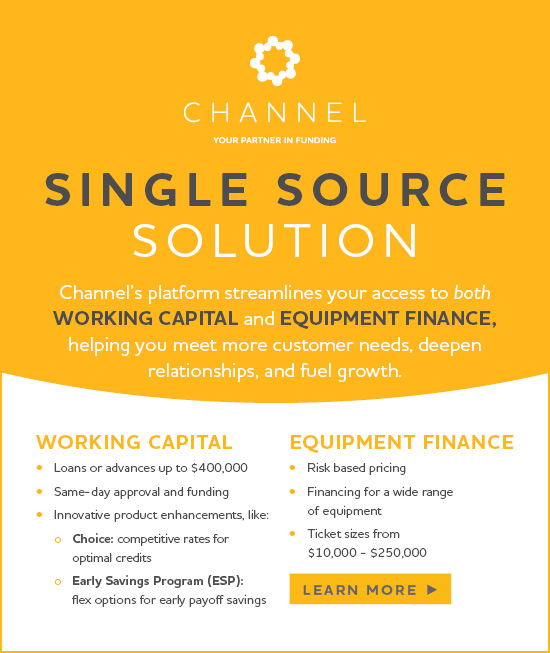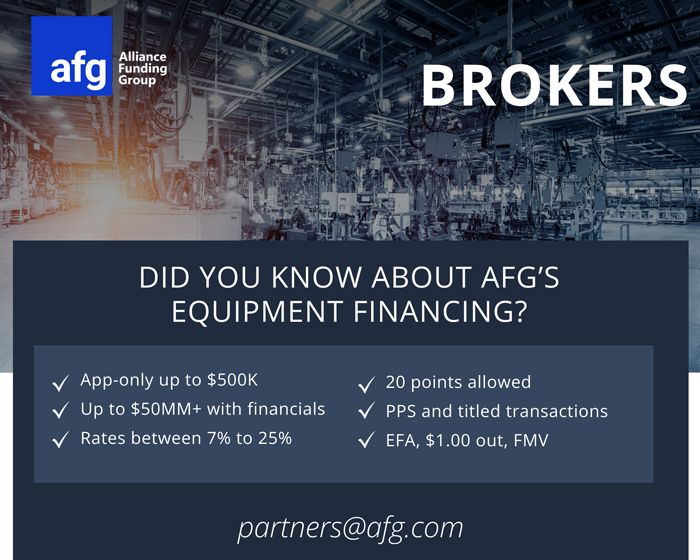
Information, news, and entertainment for the commercial
alternate financing,
bank, finance and leasing industries
Subscribe
| Search | All Lists | Site Map
Conferences/Forums |
Advertising | Archives
Columnists | Top Ten Stories Chosen by Readers
Contact: kitmenkin@leasingnews.org
![]()
Tuesday, January 6, 2026

Today's Leasing News Headlines
How to Create More Sales with Sales/Leasebacks
Free ½ Hour Webinar - Amembal & Halladay
Friday, January 16th, 12:00PM Pacific Time
New Hires/Promotions in the Leasing Business
and Related Industries
California SB 362: The Words You Use Now Matter
as Much as the Disclosures You Give
By Marshall Goldberg, Chief Legal Editor
Jump-Start 2026
By Scptt Wheeler, CLFP
Your Future Starts Now - We're Hiring!
Ameris Bank Equipment Finance
Subtraction: The Missing Skill in a World
Addicted to More
By Ken Lubin, Managing Director, ZRG Partners
All the World's Oil Reserves by Country
Graphic - Visualization
News Briefs
What America Might Look Like
With Zero Immigration
Only Five Sears Stores Remain Open
End likely for Once Mightiest American Retailer
JPMorgan’s Jamie Dimon reaps ‘$770M’
windfall in 2025: report
Minnesota Gov. Tim Walz ends reelection bid
amid welfare fraud scandal
GM, Toyota Hint at Tough Year Ahead
for U.S. Auto Sales
New Car Sales Are Rising Thanks to
Purchases by the Well-Off
You May Have Missed ---
Sports Briefs
California News
"Gimme that Wine"
This Day in History
SuDoku
Daily Puzzle
GasBuddy
Weather, USA or specific area
Traffic Live----
Wordle
######## surrounding the article denotes it is a press release, it was not written by Leasing News nor has the information been verified, but from the source noted. When an article is signed by the writer, it is considered a byline. It reflects the opinion and research of the writer.
[headlines]
--------------------------------------------------------------
How to Create More Sales with Sales/Leasebacks
Free ½ Hour Webinar - Amembal & Halladay
Friday, January 16th, 12:00PM Pacific Time

Shawn Halladay, Senior Managing Director of Amembal & Halladay, will instruct the free webinar. He has written many articles in the past at Leasing News.
Shawn Halladay has been a frequent contributor of articles, particularly regarding accounting, changes to FASB rules, tax rulings, as well as covering several of the Equipment Leasing and Finance Association events and conferences. He joined the Leasing News Advisory Board on April 17, 2006.
He presently is Chief Financial and Operating Officer of the Pitney Bowes Bank. He serves on ELFA’s Financial Accounting Committee, the ELFA Equality Steering Committee and is a member of the Equipment Leasing and Finance Foundation Editorial Review Board.
The sale-leaseback, a variation of the standard lease, is another manifestation of that versatility. Whether monetizing the user’s balance sheet or enabling innovative financial products, the sale-leaseback meets many needs.
In this 30-minute presentation, attendees will be exposed to not only the financial product benefits for lessees and lessors alike, but also the structural elements of how this oftentimes overlooked product works.
Attendees Will Learn:
- Customer motivations for entering into sale-leasebacks
- Structural components
- The requirements for recognizing gains
- The impact of transactions on the customer's balance sheet
- Risk considerations The effect on lessor and lessee tax positions
- The role of sale-leasebacks in various products, including EaaS
Who Should Attend:
Salespeople will find the information in this webinar invaluable in learning how to to unlock new sources of business and better engage their customers, while newcomers will appreciate gaining deeper insights into the industry. Back-office personnel and the operations team will gain insights into how to meet the complex requirements of sale-leasebacks in order to better support the sales team while, at the same time, mitigating the unique risks of this product.
Register Here:
https://us02web.zoom.us/webinar/register/WN_r908hlgIS3WYlktl066Arw#/registration
 |
[headlines]
--------------------------------------------------------------
New Hires/Promotions in the Leasing Business
and Related Industries


Lou Altobelli was promoted to Chief Sales Officer, Dext Capital. He is located in Roselle, Illinois. He was formerly National Sales Manager, Direct and Retail, Dext, Portland, Oregon (October, 2018 - February, 2022); Vice President, Siemens Financial Services (December, 2013 - August, 2018); Director, Sales Market Leader, Healthcare, CIT (November, 2011 - December, 2013);VP, Business Development, US Bank Equipment Finance (April, 2007 - November, 2011); Relationship Manager, GE Healthcare, GE Healthcare Finance Services(March, 2004 - April, 2007).
Full Bio:
https://www.linkedin.com/in/lou-altobelli-a9b4929/details/experience/
https://www.linkedin.com/in/lou-altobelli-a9b4929/

CJ Colton, CLFP, was Assistant Vice President, Sales, CoreTech (January, 2025 - December, 2025, Newport Beach, California .Appointed Chair, Applied Science and Innovation Committee, American Peptide Association (part-time)(December, 2025 - Present); Founder, CEO Clarvo Strategies (December, 2025 - Present); Pacific Rim Capital for 3 years, 3 months, starting as Account Executive (October, 2021 - June, 2024); Senor Account Executive (June, 2024 - December, 2024). Full Bio:
https://www.linkedin.com/in/cjcolton/details/experience/
https://www.linkedin.com/in/cjcolton/
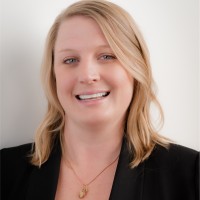
Janelle (Gorski) Klipka was hired as Senior Manager, North Mill Equipment Finance (NMEF), Windsor, Connecticut. She works remote from Wheat Ridge, Colorado. Previously, she was at Midland Equipment Finance, Denver, Colorado, starting as Asset and Operations Manager, May, 2018, promoted Portfolio and Asset Manager, February, 2024, promoted Senior Manager, Portfolio and Asset Management, working remote, (August. 2024 - December, 2025); Starting 2015, Collection Specialist, promoted Asset and Operations Manager, September, 2015 - May, 2018); Urban Lending Soluitins, starting October, 2011, Intake Associate, promoted Intake sand Reassignments Team Lead, April, 20213, promoted Customer Support Services Supervisor (May, 2014 - February, 2015); Logistics/Ebay Sales Manager, North American Technology Exchange (May, 2005 - October, 2011).
https://www.linkedin.com/in/janellegorski/

Douglas Nielsen posted "I am officially retiring. I followed 2 of my amazing brothers’ (David and Don Nielsen) footsteps to enter into this business straight out of college in 1982, 43 years in this business. I joined a small leasing broker in Chicago to start my career which lead me to work for many amazing organizations."
SVP, Chief Sales Officer, Wintrust Specialty Finance (March, 2022 - January, 2026); SVP, Business
Development, Key Equipment Finance (February, 2018 - March, 2022); SVP, Business Development, Bank of America, Global Vendor Finance (October, 2010 - February, 2018); Western Regional Manager, Corporate Capital Services, Inc. (April, 2009 - December, 2010). Full Bio:
https://www.linkedin.com/in/douglas-nielsen-8211bb19/details/experience/
https://www.linkedin.com/in/douglas-nielsen-8211bb19/
[headlines]
--------------------------------------------------------------
California SB 362: The Words You Use Now Matter
as Much as the Disclosures You Give
By Marshall Goldberg, Chief Legal Editor

As a follow-up to my earlier discussions of California’s Commercial Financing Disclosures Law, brokers and funders should be aware that Senate Bill 362, effective January 1, 2026, materially changes how pricing may be communicated to merchants, not merely what must be disclosed.
SB 362 amends the CFDL, which has been in effect since December 9, 2022, and shifts the regulatory focus from disclosure forms to ongoing communications during the application process. Providers who assume compliance ends once the disclosure is delivered are likely to be mistaken.
California Is Done With “Factor Rates”
SB 362 prohibits the use of the word “rate” in any manner that is likely to deceive a recipient. While the statute itself is brief, the legislative preamble makes the intent clear: describing pricing as a “factor rate” or “fee rate,” particularly where it materially diverges from APR, is disfavored and may trigger enforcement.
Because factor rates are almost always lower than APR, California has effectively barred the use of the term “factor rate” in merchant-facing communications for transactions of $500,000 or less. This applies not only to loans and MCAs, but also to sales-based financing and even factoring transactions.
Internal pricing discussions may still use factor rates. Communications with California merchants should not.
“Interest Rate” Must Mean an Annual Rate—or Not Be Used at All
SB 362 also restricts the use of the term “interest.” Providers may not describe pricing as “interest” in a way that suggests an annual simple interest rate when the rate being referenced is daily, weekly, or monthly.
This has real consequences for agreements and sales practices that reference:
- daily interest rates,
- weekly interest rates, or
- non-annual pricing metrics labeled as “interest.”
If a rate is not annual, calling it “interest” is now risky. Providers should review agreements, disclosures, portals, and scripts accordingly.
The New Rule Most Providers Are Underestimating: APR Must Be Repeated
The most operationally significant change under SB 362 is a new APR reminder requirement.
Once a specific offer has been extended, any time a provider states a charge, pricing metric, or financing amount during the application process, the provider must also state the APR or Estimated APR for that offer.
The statute does not define when the “application process” ends. Conservatively, it likely continues until funding occurs or the transaction is definitively declined.
This means:
- Follow-up calls asking whether a merchant intends to sign may trigger an APR reminder.
- Online portals showing offer details must include APR.
- Funding calls prior to disbursement should include an APR reminder.
This is not a one-time disclosure obligation. It is continuous.
New York Did This First—California Is Now Following
New York’s Commercial Financing Disclosure Law already imposes similar APR reminder requirements. SB 362 brings California closer to New York’s model, and national brokers and funders would be well advised to standardize compliance practices across both states.
Takeaway
SB 362 does not prohibit MCAs, sales-based financing, or alternative pricing structures. What it does prohibit is imprecise or misleading language once an offer is on the table.
For brokers and funders, compliance going forward will be less about the disclosure form itself and more about:
- how sales teams speak,
- what portals display,
- what texts and emails say, and
- what happens on funding calls.
The risk under SB 362 is not hidden fees—it is casual words.
Leasing News Advisor/Chief
Legal Editor
Marshall Goldberg
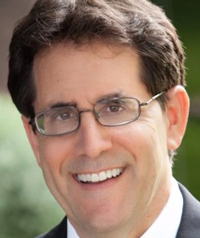
Marshall Goldberg
Glass & Goldberg, A Law Corporation
22917 Burbank Blvd.
Woodland Hills, CA 91367-4203
(818) 474-1532 Direct
(818) 888-2220 Main
(818) 888-2229 Facsimile
mgoldberg@glassgoldberg.com
www.glassgoldberg.com
Marshall F. Goldberg is the Managing Partner and a founder of Glass & Goldberg. He has served as lead counsel in well over one hundred major trials. He has been an active member and leader for over 40 years in financial institution associations, including the Equipment Leasing and Finance Association ("ELFA"), the National Vehicle Leasing Association ("NVLA"), The Alternative Finance Bar Association, and the National Equipment Finance Association (“NEFA”), and its predecessors.
Marshall has been selected for the past fourteen (14) consecutive years for inclusion in “Super Lawyers Magazine,” which represents only 5 percent of the lawyers in the State of California. Super Lawyers is a listing of outstanding lawyers, chosen from a rigorous, multiphase process, who have attained high peer recognition and professional achievement.
[headlines]
--------------------------------------------------------------
Jump-Start 2026
By Scott Wheeler, CLFP

The new year brings fresh goals, renewed energy, and expanded opportunities for originators in the commercial equipment finance and leasing industry. With continued advancements in technology and operational efficiencies, originators now have more tools than ever to increase production and elevate performance in 2026. The key is simple: use these tools intentionally and early.
There is no better motivator than a strong first quarter. What originators do in January and February often sets the tone—and the trajectory—for the entire year.
Below are several high‑impact suggestions to jump‑start 2026.
- Set Bold 90-Day Goals: Define ambitious but achievable goals for the first quarter, paired with specific activities that must be completed in the next 90 days. Clarity drives action, and action drives results.
- Create or Revisit Your Personal Strategy: Success flows from executing a well‑defined personal strategy. Every call, meeting, and activity should align with that strategy. A strong personal strategy helps originators focus on the activities that consistently produce the greatest returns.
- Commit to Developing Key Accounts: I recently challenged a group of originators to commit to developing one new key account each quarter in 2026. A true key account is a relationship that can materially change the trajectory of an originator’s annual production. Each new key account should have the potential to increase total production by 20% to 30%.This is how careers accelerate.
- Complete a 2025 AAR (After-Action-Report): Reflection is a powerful tool. Ask yourself:
1) What was successful in 2025?
2) What was not successful?
3) What will you continue doing—and why?
4) What will you discontinue—and why?
A disciplined AAR provides clarity, eliminates waste, and reinforces the behaviors that drive growth.
Originators in the commercial equipment finance and leasing industry control their own destiny and success. Take ownership of your actions and create your own success.
The possibilities are endless
Scott A. Wheeler, CLFP
Wheeler Business Consulting
1314 Marquis Ct.
Fallston, Maryland 21047
Phone: 410 877 0428
Fax: 410 877 8161
Email: scott@wheelerbusinessconsulting.com
Web: www.wheelerbusinessconsulting.com
Wheeler Business Consulting is working with individual originators and sales teams throughout the industry to ensure that they are well positioned in the market, capturing their fair share of business, and outperforming the competition. To schedule a one-on-one meeting contact Scott Wheeler at: scott@wheelerbusinessconsulting.com
[headlines]
--------------------------------------------------------------
Help Wanted Ad
Ameris Bank Equipment Finance
--------------------------------------------------------------
Subatraction: The Missing Skill in a World Addicted to More
By Ken Lubin, Managing Director, ZRG Partners

Most people wake up every day thinking the answer is more.
More goals. More productivity hacks. More noise. More intensity. Stack enough “more” together and eventually you’ll break through, right?
That’s the lie the world runs on.
High performers—the real ones, not the LinkedIn caricatures—aren’t adding.
They’re eliminating.
They’re not expanding their to-do lists; they’re burning them down to the essentials.
Because here’s the truth:
You don’t rise by doing more.
You rise by carrying less.
Every breakthrough in your life, business, or physical performance has come from subtraction—whether you realized it or not. The moment you stopped chasing other people’s expectations. The moment you cut the habits that dragged you down. The moment you narrowed your focus to the one thing that actually mattered.
That’s when everything shifted.
The world teaches accumulation.
High performers practice reduction.
It shows up everywhere:
Athletics:
The fastest athletes aren’t the ones carrying more muscle—they’re the ones carrying the right muscle. Every ounce is intentional. Every ounce serves a purpose.
Business:
Elite operators aren’t busy.
They’re precise. They say “no” 10x more than they say “yes.”
They don’t chase every opportunity—they choose the ones only they can win.
Life:
Peace doesn’t come from adding vacations, gadgets, or self-care rituals.
Peace comes from cutting the shit that keeps you exhausted.
But subtraction is uncomfortable.
It forces you to face the truth:
Most of what you’re doing doesn’t matter.
Most of what you’re carrying isn’t helping.
And most of the expectations weighing you down aren’t even yours.
You weren’t built to be everything to everyone.
You were built to be exceptional at the few things that define you.
When you start letting go—truly letting go—you unlock a different gear:
- Clarity becomes your operating system.
- Conviction becomes your compass.
- Your time becomes yours again.
- And your energy stops leaking into places that don’t deserve it.
The world is addicted to “more” because “more” feels safe.
- It keeps you distracted.
- It keeps you running in circles.
- It keeps you from confronting the simplicity of the truth:
The life you want is hiding under the things you’re afraid to release.
So here’s your challenge:
Don’t ask, “What should I add?”
Ask, “What must I subtract?”
- Cut the noise.
- Cut the excuses.
- Cut the extra weight—physically, mentally, professionally.
- Strip your system down to its essence, and watch your performance explode.
Because the top 1% don’t win because they do more.
They win because they’ve mastered the discipline the world avoids:
Letting go.

Ken Lubin
Managing Director
ZRG Partners, LLC
Americas I EMEA I Asia Pacific
klubin@zrgpartners.com
C: 508-733-4789
https://www.linkedin.com/in/klubin
--------------------------------------------------------------
All of the World’s Oil Reserves by Country,
in One Visualization

Key Takeaways
- Just four countries control more than half of the world’s proven oil reserves.
- Despite the energy transition, fossil fuels still account for nearly 70% of global energy demand.
Oil remains one of the most strategically important resources in the global economy. It powers transportation systems, underpins industrial activity, and continues to shape geopolitics and trade flows. While renewable energy is growing, oil still plays a dominant role in meeting global energy needs.
This visualization ranks countries by the size of their proven oil reserves at the end of 2024. The data for this graphic comes from OPEC’s Annual Statistical Bulletin 2025. Figures represent proven oil reserves as of year-end 2024 and are measured in billions of barrels. The data includes conventional crude oil as well as oil sands.
by VisualCapitalist

[headlines]
--------------------------------------------------------------

News Briefs
What America Might Look Like With Zero Immigration
https://www.nytimes.com/2025/12/28/business/us-immigration-trump-1920s.html
Only Five Sears Stores Remain Open
End likely for Once Mightiest American Retailer
https://www.nytimes.com/2025/12/26/business/sears-seritage-edward-lampert.html
JPMorgan’s Jamie Dimon reaps ‘$770M’
windfall in 2025: report
https://nypost.com/2026/01/05/business/jpmorgans-jamie-dimon-reaps-770m-windfall-in-2025-report/
Minnesota Gov. Tim Walz ends reelection bid
amid welfare fraud scandal
https://www.cnn.com/2026/01/05/politics/tim-walz-minnesota-reelection
GM, Toyota Hint at Tough Year Ahead
for U.S. Auto Sales
https://www.wsj.com/business/autos/auto-car-sales-usa-2026-44ddcaa6?mod=business_lead_pos3
New Car Sales Are Rising Thanks to
Purchases by the Well-Off
https://www.nytimes.com/2026/01/05/business/new-car-sales.html
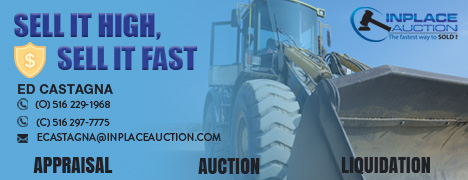
[headlines]
--------------------------------------------------------------

A New Use for Airline Miles:
Gliding Past the Velvet Rope
https://www.nytimes.com/2026/01/05/travel/travel-credit-cards-members-only.html
Ties between California and Venezuela go back
more than a century with Chevron
https://www.latimes.com/california/story/2026-01-05/ties-between-california-venezuela-go-back-more-than-century-with-chevron
[headlines]
--------------------------------------------------------------

Sports Briefs---
Why Does the College Football Playoff
Have So Many Boring Blowouts?
https://www.wsj.com/sports/football/college-football-playoff-blowouts-97696dcb?mod=hp_featst_pos3
jason Kelce Can’t Promise He’ll Keep His Shirt
On at Taylor Swift’s Wedding
https://www.wsj.com/sports/football/jason-kelce-taylor-swift-wedding-podcast-travis-6648d1ae?mod=hp_featst_pos5
[headlines]
--------------------------------------------------------------
![]()
California News Briefs---
Waymo pauses robotaxi service in San Francisco after
blackout chaos - Musk says Tesla car service unaffected
https://www.cnbc.com/2025/12/21/waymo-robotaxi-san-francisco-blackout.html
L.A.’s hydrants ran dry during the fires.
Residents are still demanding solutions
https://www.latimes.com/environment/story/2025-12-17/la-fires-water-system
[headlines]
--------------------------------------------------------------
Gimme that Wine
![]()
http://www.youtube.com/watch?v=EJnQoi8DSE8
When will the most diverse wine-growing region
in California finally get its moment?
https://www.sfchronicle.com/food/wine/article/lodi-california-wine-winery-21171904.php
Where Wine Won In 2025—And What
The Growth Signals Are Telling Us
https://www.forbes.com/sites/ericaduecy/2025/12/30/where-wine-won-in-2025---and-what-the-growth-signals-are-telling-us/
[headlines]
----------------------------------------------------------------
![]()
This Day in History
https://leasingnews.org/archives/Dec2024/12_23.htm#history
-------------------------------------------------------------
SuDoku

The object is to insert the numbers in the boxes to satisfy only one condition: each row, column and 3x3 box must contain the digits 1 through 9 exactly once. What could be simpler?
--------------------------------------------------------------
Daily Puzzle

How to play:
http://www.setgame.com/set/puzzle_frame.htm
Refresh for current date:
http://www.setgame.com/set/puzzle_frame.htm
--------------------------------------------------------------

http://www.gasbuddy.com/
http://www.gasbuddy.com/GB_Map_Gas_Prices.aspx
http://www.gasbuddy.com/GB_Mobile_Instructions.aspx
--------------------------------------------------------------
Weather

See USA map, click to specific area, no commercials
--------------------------------------------------------------
Traffic Live---
Real Time Traffic Information
You can save up to 20 different routes and check them out with one click,
or type in a new route to learn the traffic live
--------------------------------
Wordle
https://www.powerlanguage.co.uk/wordle/
How to Play
https://www.today.com/popculture/popculture/wordle-know-popular-online-word-game-rcna11056
![]()

